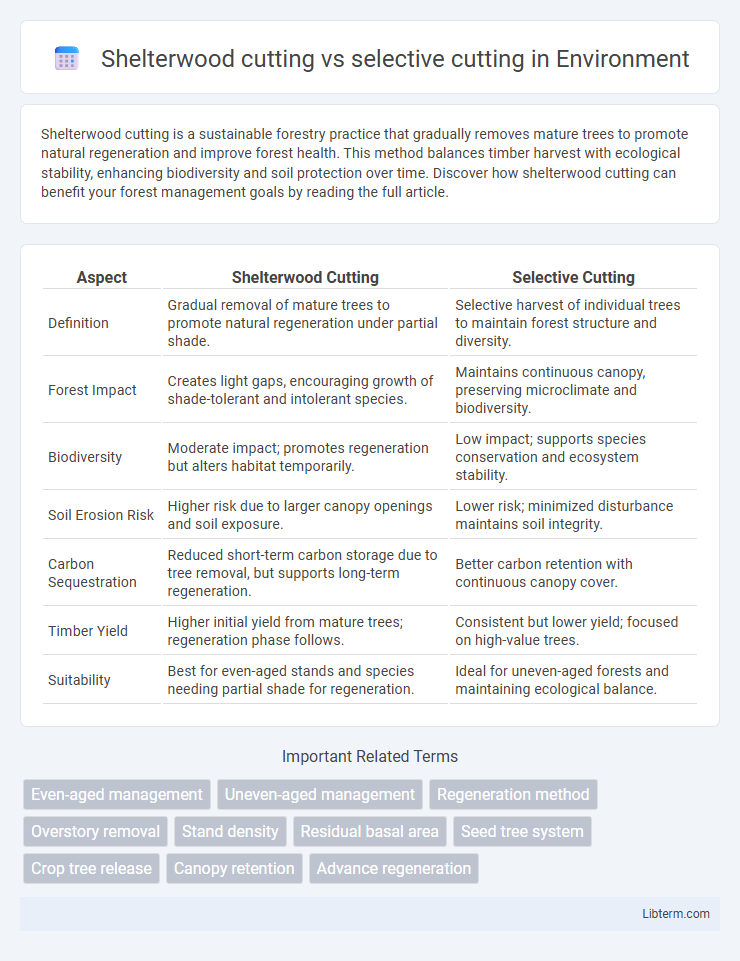Shelterwood cutting is a sustainable forestry practice that gradually removes mature trees to promote natural regeneration and improve forest health. This method balances timber harvest with ecological stability, enhancing biodiversity and soil protection over time. Discover how shelterwood cutting can benefit your forest management goals by reading the full article.
Table of Comparison
| Aspect | Shelterwood Cutting | Selective Cutting |
|---|---|---|
| Definition | Gradual removal of mature trees to promote natural regeneration under partial shade. | Selective harvest of individual trees to maintain forest structure and diversity. |
| Forest Impact | Creates light gaps, encouraging growth of shade-tolerant and intolerant species. | Maintains continuous canopy, preserving microclimate and biodiversity. |
| Biodiversity | Moderate impact; promotes regeneration but alters habitat temporarily. | Low impact; supports species conservation and ecosystem stability. |
| Soil Erosion Risk | Higher risk due to larger canopy openings and soil exposure. | Lower risk; minimized disturbance maintains soil integrity. |
| Carbon Sequestration | Reduced short-term carbon storage due to tree removal, but supports long-term regeneration. | Better carbon retention with continuous canopy cover. |
| Timber Yield | Higher initial yield from mature trees; regeneration phase follows. | Consistent but lower yield; focused on high-value trees. |
| Suitability | Best for even-aged stands and species needing partial shade for regeneration. | Ideal for uneven-aged forests and maintaining ecological balance. |
Introduction to Shelterwood Cutting and Selective Cutting
Shelterwood cutting is a silvicultural technique that involves the gradual removal of mature trees to promote natural regeneration under the partial shade of residual trees, ensuring continuous forest cover and improved seedling establishment. Selective cutting, on the other hand, targets the removal of specific trees based on criteria such as size, species, or health, aiming to maintain uneven-aged stands and biodiversity without clear-cutting areas. Both methods support sustainable forest management but differ in their approach to regeneration and stand structure maintenance.
Defining Shelterwood Cutting
Shelterwood cutting is a silvicultural method that gradually removes mature trees in a series of cuts to establish a new generation of seedlings under the partial shade of remaining trees. This technique contrasts with selective cutting, which involves the removal of individual trees across the stand without creating uniform shelter. Shelterwood cutting promotes even-aged forest regeneration by ensuring adequate light and protection for young seedlings, optimizing forest productivity and biodiversity.
Understanding Selective Cutting
Selective cutting involves the strategic harvesting of individual trees based on criteria such as size, species, or health, promoting forest diversity and continuous canopy cover. This method reduces environmental impact by preserving ecosystem functions and encouraging natural regeneration of shade-tolerant species. In contrast to shelterwood cutting, which removes trees in phases to establish even-aged stands, selective cutting maintains uneven-aged forests and supports diverse wildlife habitats.
Ecological Impacts: Shelterwood Cutting vs Selective Cutting
Shelterwood cutting promotes even-aged forest regeneration by gradually removing mature trees, which increases light availability but can temporarily disrupt wildlife habitats and soil stability. Selective cutting preserves a multi-aged forest structure, maintaining biodiversity and minimizing soil erosion while providing continuous cover for sensitive species. Both methods impact ecosystem dynamics, but selective cutting generally supports higher ecological resilience and habitat complexity.
Timber Yield and Forest Regeneration
Shelterwood cutting promotes uniform timber yield by gradually removing mature trees, enhancing natural regeneration through increased light exposure and seed dispersal. Selective cutting focuses on harvesting specific trees, often maximizing immediate timber quality but potentially resulting in uneven regeneration and variable yield. Both methods impact forest structure differently, with shelterwood supporting even-aged stands and selective cutting maintaining uneven-aged forests.
Biodiversity Considerations in Both Methods
Shelterwood cutting promotes biodiversity by gradually opening the canopy, allowing light to reach understory plants and encouraging regeneration of shade-tolerant species, which supports diverse wildlife habitats. Selective cutting maintains structural complexity by removing individual trees and preserving continuous canopy cover, benefiting species dependent on mature forest conditions. Both methods aim to balance timber production with ecosystem health, but shelterwood cutting often enhances species diversity by fostering varied successional stages, while selective cutting minimizes disturbance to existing flora and fauna.
Suitability for Different Forest Types
Shelterwood cutting is suitable for shade-tolerant species and uneven-aged stands, promoting natural regeneration by providing partial canopy cover. Selective cutting works best in mixed-species forests and mature stands where specific trees are targeted, preserving overall forest structure and biodiversity. Both methods offer advantages depending on species composition, forest age, and management goals.
Economic Costs and Benefits
Shelterwood cutting incurs higher initial economic costs due to extensive planning and implementation but promotes uniform timber regeneration, enhancing long-term income stability. Selective cutting involves lower immediate expenses and maintains continuous forest cover, enabling steady, albeit potentially less predictable, revenue streams. Both methods offer economic benefits by sustaining forest productivity, with shelterwood maximizing timber quality and selective cutting optimizing harvesting flexibility.
Sustainability and Long-Term Management
Shelterwood cutting promotes sustainability by gradually removing mature trees to maintain continuous canopy cover, which supports natural regeneration and soil protection over the long term. Selective cutting targets specific trees based on criteria such as size or species, aiming to preserve forest structure and biodiversity while minimizing ecological disruption. Both methods contribute to long-term forest management by balancing timber yield with ecosystem health, but shelterwood cutting offers a more controlled environment for natural regeneration and habitat stability.
Choosing the Right Cutting Method
Choosing the right cutting method depends on forest composition, management goals, and ecological impact. Shelterwood cutting promotes natural regeneration by removing mature trees in phases, enhancing sunlight for seedling growth, while selective cutting targets only specific trees to maintain continuous canopy cover and biodiversity. Evaluating site conditions and desired outcomes ensures sustainable forest management and optimal timber yield.
Shelterwood cutting Infographic

 libterm.com
libterm.com